There’s no question that wars create suffering; they have, all through history. War, on an individual basis, is nothing more than a massive survival scenario, being played out by thousands of people at the same time. Each is trying to survive the horrors of war, whether they are in the military or civilians trapped in the war zone.
Part of surviving any war is finding sufficient food to survive. Throughout much of human history, armies lived off the land, taking food from the people living in the war zone, often by force. Modern armies have a huge logistical tail, which is supposed to provide that food, along with everything else that military forces need. But even then, things can happen; supplies don’t make it through and soldiers end up being forced to live off the land.
World War II in Europe
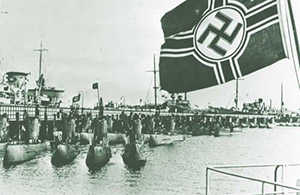 World War II was no exception. The greatest war the world’s armies ever fought was a logistical nightmare for both sides. Due to their limited resources, Germany’s forces survived the old-fashioned way, laying heavy levies on the people of the occupied countries they had invaded. The allies didn’t have it much better though, having to ship everything across the Atlantic Ocean, where German U-boats sunk some 3,500 cargo vessels.
World War II was no exception. The greatest war the world’s armies ever fought was a logistical nightmare for both sides. Due to their limited resources, Germany’s forces survived the old-fashioned way, laying heavy levies on the people of the occupied countries they had invaded. The allies didn’t have it much better though, having to ship everything across the Atlantic Ocean, where German U-boats sunk some 3,500 cargo vessels.
Magazines of the time featured advertisements, run by various major corporations and showing how well our military forces ate, wherever they were serving around the world. That was true, for troops in garrison, but the reality on the battlefield was something quite different. At times, shortages caused by the war forced soldiers to go days without eating or to come up with their own food, living off the land. With the high energy expenditure common in warfare, troops could only go so long without eating, before they were debilitated.
These shortages forced everyone in the war zone to use their imagination to keep themselves fed; Germans, Allied forces and civilians alike. Some of the things they ate were rather unique.
Egg Biscuits
Soldiers in the field ate a lot of egg biscuits. But these weren’t the egg biscuits that you can buy at just about any fast food restaurant in the United States. Rather, this was the name given to a military ration bread that the British made. We would recognize it more closely as an equivalent to hardtack. Made of mostly flour, there was little in the way of leaven, sugar eggs or butter in this tough, hard bread.
While not exactly something to please the palate, egg biscuits or hardtack is at least high in carbohydrates, providing energy. Other than that though, it is severely lacking in nutrition, so it doesn’t make for much of a diet, if you’re depending on it.
 Bully Beef
Bully Beef
Bully Beef was actually a form of canned corned beef which was universally despised by soldiers. It falls into the category of being survival food because it was not normally on the menu. Rather, army units were issued Bully Beef as an emergency ration, to be used only in the case where their normal ration deliveries were destroyed or delayed by combat action.
Use of Bully Beef had to be authorized by the local military commander. Even so, when there was nothing else available, units on the line would sometimes eat Bully Beef for days on end, adding to their disdain for this emergency food.
Turnip Bread
Throughout Europe, bread is a dietary staple. But what do you do when there isn’t a wheat harvest to turn into grain? You use whatever is available, drying roots and other edibles and grinding them into flour. One common vegetable used for this was turnips. While I doubt that the resulting bread tasted anything like wheat bread, it was at least nutritious.
Stinging Nettles Soup
The stinging nettle is an annoying weed. Much like poison ivy, it causes a skin rash, although the rash caused by stinging nettle doesn’t last as long as the other. But once cooked, the poison which causes the rash is destroyed, leaving a fibrous green vegetable, which is high in nutritional value.
The stinging nettle can be found all over Europe, often alongside country roads and paths through the woods. Gathered carefully and cooked, the stinging nettle makes a tasty soup that was popular with civilians and soldiers alike.
Related: How to Cook Spring Nettles
Horsemeat
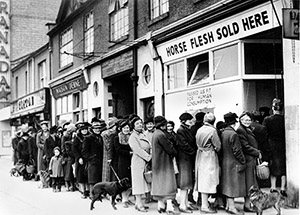
Before World War II, much of Europe was still cultivated by animal power, specifically draft horses. With the Germans taking much of the food produced by farms in the occupied countries, many people turned to killing and eating these draft horses to survive.
One noted time when horsemeat helped people to survive was the siege of Warsaw, Poland. The German Army had the city surrounded, with tens of thousands of inhabitants cut off from any supply. City officials ordered the killing of horses in the city, to provide people with food.
Let’s Not Forget the Pacific War
While the war in Europe receives a lot of attention, that wasn’t the only part of World War II. The war in the Pacific was just as violent, with the Marine Corps, the Army and the Navy working together to defeat Japanese aggression, taking back islands that the Japanese had conquered and occupied.
The battle of Guadalcanal was the turning point in the Pacific War. The first major Allied offensive, it was deemed necessary to capture Guadalcanal and the airfield that the Japanese were building on it. Otherwise, the Japanese would be within range to bomb Australia, which became the Allied headquarters and staging area in the Pacific.
The rush to take Guadalcanal force the Marines to go in not fully prepared. The Navy, who was concerned about losing any more ships after the beating they had taken at Pearl Harbor, pulled their ships away from the island, shortly after the landing. This left the Marines on the beach short on supplies, including food.
The Marines survived primarily by eating captured Japanese rations, as there was a shortage of American ones. These scavenged rations became the mainstay of their diet, up until the supply pipeline could be fully put into place. By then, the Army was ready to take over the defense of Guadalcanal, freeing up the Marines to take another island away from Japanese forces.
You may also like:
7 Survival Foods Made by Soldiers During WWI
Survival Foods Made by Soldiers During WWI
The Long-Lasting Food That Amish Pioneers Turned To In Dark Times (Video)

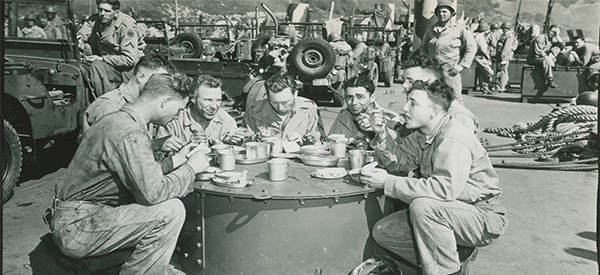
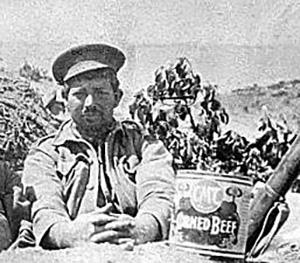 Bully Beef
Bully Beef


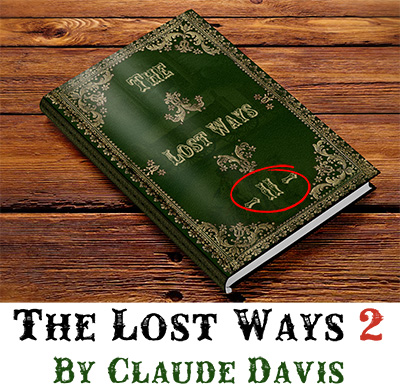

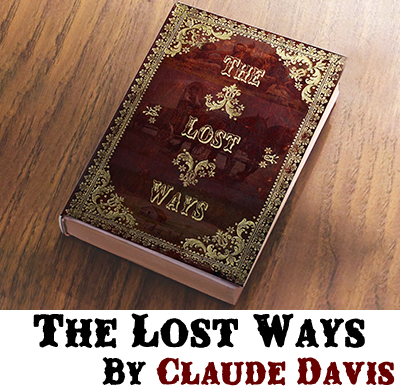




Great System. Love the Book y’all sent!!!
Claude Davis is a genius. He’s written two books, “The Lost Ways”, and “The Lost Ways II”. If you haven’t heard of them, you should look them up. In a real SHTF scenario, these books could easily become the bibles of survival.
Writer and Ornithologist E.B. Sledge was a mortarman with the !st Marines at Peleliu and Okinawa. His book With The Old Breed is must reading, one of the few graphic, honest accounts of combat a soldier has ever written. Weather and terrain caused a complete breakdown in sanitation and food supply at the height of the fighting on Okinawa, the men fighting desparately while knee deep in mud, shit, and corpses with almost nothing to eat for weeks at a time. Gives a new appreciation of the meaning of ‘survivor’.
You forgot that fine Americsn product known as Spam. The entry of the US into the war brought tons of Spam to the UK where it was consumed by troops and civilians alike. In fact, Spam permitted a sgnificant increase in the British meat ration, and is still consumed in quantity today.
Same thing in Hawaii. Spam is still popular there, with Hawaii consuming the highest per capita amount in the U.S.
Miss Kitty, yes, I know. There are even restaurants that specialize in Spam dishes. Yummy!
Restaurants, spam dishes, just doesn’t seem right those two being together.very difficult to make spam taste good, just too darn salty
LOL – yeah a restaurant specializing in spam kinda boggles the mind. Nevertheless, it does have its uses to those of us who grew up eating it. There is a low-sodium version available, or you can draw out some of the salt and fat by poaching it briefly then draining off the water. I would classify it with bacon as something that works best as a flavor enhancer – diced, browned and mixed with scrambled eggs, mac n cheese or hash browned potatoes for example. I must admit, I don’t like the newer packaging. The pop top is convenient, but I’ve gotten a couple of cans that the seal had been compromised on and the product spoiled – never remember that happening with the old key- wind-around-the-can method. I have a book on “convenience store gourmet cooking” that has a recipe in it for an hors d’oeuvre made with a horse made from spam filled with melted cheese – I think they called it the Trojan Horse. Ridiculous, but sounded fun to try!
It’s funny, but my father who is a retired Marine once said that in vietnam, after eating MRE’s or forced to eat snakes or other crap, they would relish surplus canned rations. It would be nice if they could have the same stuff sold in grocery stores and a few staples to make pancakes, breads or biscuits, but logistically it’s easier to provide meal packs than individual selections. Nowadays, they have military chefs, but back then it was powdered milk, eggs and other such fair.
I know about the popularity of SPAM, and that there are recipes for this canned meat wonder, but it’s so darn salty and fatty that it’s not very healthy. But, luckily we have other choices: Dinty Moore Beef Stew, Chef Boyardee (Ravioli, Spaghetti O’s), Vienna sausages, Devilwood spreads. Some are healthier than others, but in an emergency we can get by and must make do.
For people with special diets there is an assortment of canned meats not to mention canned fruits, vegetables and pudding for desert. Hormel actually makes low sodium canned meat.
I must admit, I can sure chow down on ramen noodles, bullion, canned chicken and a can of peas and carrots. I’m also happy eating ravioli and spaghetti for a few days. It cheers people up when you have endured a hurricane and have no power.
My wife invented Spam sushi before it was ever popular in the any restaurants. The salty taste of the Spam sets off the white rice nicely.
As a personal taste, I have always liked Spam. It is one of the mainstays of my emergency food supply. On the other hand, the meat sources that Frank lists are low on my list of preferred foods. I think Vienna Sausages are just plain nasty, although that is a view I have developed in later life. In my youth I thought Vienna Sausage was a gourmet dish.
Tell you what, Frank, I will trade you a can of Vienna Sausage for a can of Spam. How’s that? Sound like a deal?
Good info to have! Thanx!
The Second World War, sometimes known as World War II, lasted from 1939 to 1945 and is regarded as the biggest conflict ever recorded in human history. Germany’s dictator and Fuhrer was Adolf Hitler. The Duce/Dictator of Italy throughout the war was Benito Mussolini. 2. See https://edubirdie.com/examples/world-war-2/ to read an article on it. Millions of people died in the most catastrophic war in recorded history.
xhelo
ATV’s for Sale | 4 Wheelers For Adults, Youth & Kids | Quads Online | Don’t shop for quads on best price alone! We offer a wide range of atv 4-wheelers for sale online that meet all your specifications including size, use, terrain, transmission and of course, price.
Art Attackk, one of the most trusted companies—we are a full-fledged and one-stop website development company in Delhi. We help different industries and businesses to evolve and showcase their presence in the digital world.
I really like your posts, I usually prefer to peruse quality material that has accurate data on the topic. thanks for sharing. This is a really amazing post.
An intriguing combination of topics— from the mysterious charm of the nightjar to the elegance of a black Maltese dog and the unique allure of albino monkeys. A fascinating guide through the diverse world of captivating pets!
During World War II, humanity’s resilience shone brightest amid the darkest of times. These ‘5 Survival Foods’ weren’t just sustenance. They were lifelines, embodying the ingenuity and perseverance of those faced with unimaginable odds. very nice blog and informative.
this information is very valuable and today every information on twitter Buy twitter followers India
Discover the five essential survival foods that were crucial during World War II, offering sustenance and hope in times of scarcity.
https://shivgangadigital.com/
PGD cost in Nairobi is competitive, offering advanced genetic screening.
It’s fascinating to learn about the survival foods soldiers relied on, like Bully Beef and Turnip Bread. Despite its disdain, Bully Beef played a crucial role as an emergency ration during times of supply disruption. Somk
thanks
War is against Humanity!
During World War II, five survival foods that saved lives included powdered milk, canned meats, hardtack, dried beans, and ration biscuits. These non-perishable, nutrient-dense foods were essential for sustaining soldiers and civilians. For businesses looking to optimize their online presence, “omitechno” is the best digital marketing agency in Delhi
I really like your posts, I usually prefer to peruse quality material that has accurate data on the topic. thanks for sharing.
At SunyMed, we are dedicated to transforming the healthcare experience through cutting-edge medical technologies, compassionate care, and patient-centered solutions. Our mission is to provide individuals and families with the highest quality medical services, from preventive care to advanced treatment options.
Tiranga game App is a popular online gaming platform from India. Download Tiranga App and you get a chance to play more than eight categories. Tiranga App lets you showcase your sports expertise in colour prediction and many other games. With Tiranga App Login, turn your knowledge into an opportunity to win big prizes worth lakhs.
The name “Cactus Jack” is a personal reference to a childhood nickname given to Scott by his father, symbolizing resilience, independence, and a rebellious spirit. The moniker also represents Scott’s embrace of the desert landscape, which aligns with his larger-than-life persona. This branding has permeated his music, merchandise, and various collaborations, giving birth to a unique culture that fans and followers embrace wholeheartedly.
During World War II, survival foods like canned goods, powdered milk, dried meats, hardtack, and root vegetables played a critical role in sustaining soldiers and civilians alike. These durable and nutrient-rich staples were vital in enduring food shortages, rationing, and harsh conditions, showcasing human resilience in the face of adversity.
https://trendychapter.com/is-henna-cultural-appropriation/